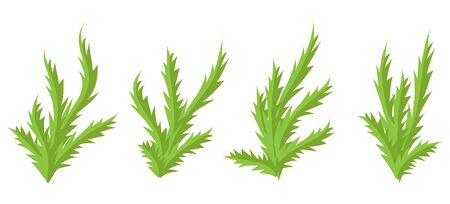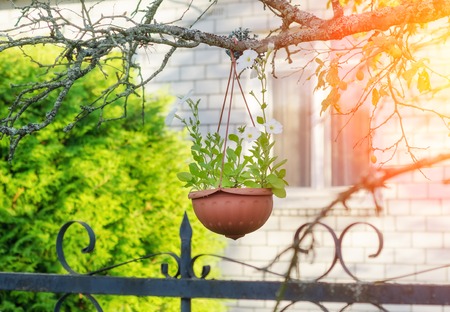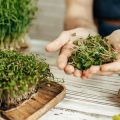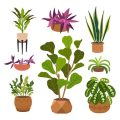1. Introduction to Indoor Herb Gardening
Growing herbs indoors is a fun and rewarding way to bring fresh flavor into your kitchen all year long. Whether youre a beginner gardener or just looking for a low-maintenance green addition to your home, indoor herb gardening makes it easy to enjoy homegrown freshness without needing a backyard or perfect weather.
One of the biggest benefits of growing herbs indoors is year-round availability. You don’t have to wait for spring or summer—your favorite herbs can thrive inside no matter the season. Plus, having herbs within arm’s reach means you’ll always have fresh ingredients ready when cooking.
Another great advantage is ease of access. Instead of running to the grocery store for a handful of basil or parsley, you can simply snip what you need right from your windowsill. This not only saves time and money but also reduces waste since you’re only harvesting what you’ll use.
And let’s not forget the satisfaction of growing your own food. There’s something special about nurturing a plant from seed or starter and watching it flourish in your home. It’s good for the environment, good for your health, and just feels good overall.
Here are some quick highlights of why indoor herb gardening is worth trying:
| Benefit | Description |
|---|---|
| Year-Round Freshness | Grow herbs anytime, regardless of outdoor weather |
| Convenience | Easily harvest herbs right from your kitchen |
| Cost-Effective | Save money by growing instead of buying fresh herbs |
| Sustainability | Reduce packaging waste and lower your carbon footprint |
| Pleasure & Wellness | Enjoy the process and boost mental well-being with indoor greenery |
If youre ready to get started, youre in the right place. In this series, we’ll explore the top 10 easiest herbs to grow indoors year-round—perfect for beginners and seasoned plant lovers alike.
2. Essential Tips for Growing Herbs Indoors
If youre looking to grow herbs indoors all year long, it’s important to create the right environment to help them thrive. Whether you’re growing basil on your kitchen windowsill or rosemary in a sunny corner of your living room, here are the essential factors to keep in mind.
Lighting: Give Them Plenty of Sun
Most herbs love sunlight—at least 6 hours a day. A south-facing window is ideal. If natural light is limited, consider using grow lights to supplement. LED grow lights are energy-efficient and provide the full spectrum of light that herbs need.
Best Windows for Herb Growth
| Window Direction | Light Level | Recommended Herbs |
|---|---|---|
| South-facing | High light (6+ hours) | Basil, Rosemary, Thyme |
| East-facing | Moderate morning light | Mint, Parsley, Chives |
| West-facing | Moderate afternoon light | Cilantro, Oregano |
| North-facing | Low light | Needs supplemental grow lights |
Containers: Let Them Breathe and Drain
The right container can make a big difference. Use pots with good drainage holes to prevent root rot. Terracotta pots are a great option because they allow air flow and help absorb excess moisture. Make sure to place a saucer underneath to catch any water runoff.
Container Tips:
- Avoid using containers without drainage holes.
- Select pot sizes based on the herb’s mature size—around 6-8 inches for most herbs.
- Add a layer of small pebbles at the bottom for extra drainage if needed.
Watering: Keep It Just Right
Overwatering is one of the most common mistakes in indoor herb gardening. Most herbs prefer slightly moist soil but not soggy. Always check the top inch of soil—if it’s dry, it’s time to water. Use room-temperature water and pour slowly until it drains from the bottom.
Watering Frequency Guide (General):
| Herb Type | How Often to Water (Indoor) |
|---|---|
| Basil | Every 2–3 days or when topsoil feels dry |
| Rosemary | Once a week (let soil dry between watering) |
| Mint | Every 2–3 days (keep evenly moist) |
| Thyme & Oregano | Every 5–7 days (tolerates drier soil) |
Temperature and Humidity: Keep It Comfortable
Your indoor herbs like temperatures between 65–75°F during the day and not below 55°F at night. Most common herbs don’t need high humidity, but if your home is very dry—especially in winter—you can increase humidity by misting occasionally or placing a tray with water near the plants.
Quick Climate Tips:
- Avoid placing herbs near cold drafts or heating vents.
- If leaves turn yellow or drop off, check for temperature stress or dry air.
- A small fan nearby can help prevent mold and improve airflow.
By paying attention to light, containers, watering habits, and indoor climate, you’ll be well on your way to keeping your favorite herbs healthy and flavorful all year long.

3. Top Picks for Low-Maintenance Indoor Herbs
Discover a curated list of the easiest herbs to grow indoors all year long, ideal for beginners or anyone with limited time. These herbs require minimal care, thrive in indoor conditions, and can be grown on a sunny windowsill or under grow lights. Whether youre looking to spice up your cooking or just want some greenery around your kitchen, these low-maintenance picks are perfect for any home.
Top 10 Easiest Herbs to Grow Indoors
| Herb | Why Its Easy | Light Needs | Watering |
|---|---|---|---|
| Basil | Fast-growing and perfect for windowsills | 6-8 hours of sunlight | Keep soil moist but not soggy |
| Mint | Very hardy and grows quickly | Indirect light or partial sun | Water when topsoil feels dry |
| Chives | Tolerant of various light levels | Bright light preferred | Keep soil evenly moist |
| Parsley | Low-maintenance and versatile in cooking | Bright indirect light | Water when topsoil is dry |
| Cilantro | Quick to sprout and easy to manage indoors | At least 4-5 hours of sun daily | Mist regularly; keep soil slightly damp |
| Dill | No-fuss herb that grows well from seeds | Full sun (or grow lights) | Avoid overwatering; let soil dry slightly between waterings |
| Thyme | Drought-tolerant and compact in size | 6+ hours of sunlight daily | Let soil dry out between watering |
| Lemon Balm | Fragrant and forgiving with watering schedules | Partial to full sunlight | Water when top inch of soil is dry |
| Sage | Tough plant that thrives indoors with little care | Bright light; south-facing window ideal | Sparingly—allow soil to dry out between waterings |
| Oregano | Loves the heat and doesnt need much attention | 6+ hours of direct sunlight or grow lights | Drought-tolerant; water sparingly once established |
Tips for Keeping Indoor Herbs Happy Year-Round:
- Use containers with drainage: This helps prevent root rot from overwatering.
- Avoid overcrowding: Give each plant enough space to breathe and grow.
- Rotate pots weekly: If using window light, rotate herbs so all sides get even exposure.
- Pinch back growth: Regular trimming encourages bushier plants and prevents legginess.
- Add humidity in winter: Indoor air can get dry—use a humidity tray or mist occasionally.
No matter your skill level or schedule, these easy-to-grow herbs can bring fresh flavor and fragrance into your home all year long.
4. How to Care for Your Indoor Herb Garden
Once youve chosen the easiest herbs to grow indoors, like basil, mint, or chives, its important to understand how to care for them so they stay healthy and flavorful all year round. Proper maintenance helps your herbs thrive and ensures you get the most out of your indoor garden.
Pruning Techniques
Pruning is essential for encouraging bushy growth and preventing your herbs from becoming leggy. Heres a quick guide on how to prune some of the most common indoor herbs:
| Herb | When to Prune | How to Prune |
|---|---|---|
| Basil | Once it has 6–8 leaves | Pinch off the top sets of leaves just above a leaf node |
| Mint | Regularly throughout growing season | Trim stems back by one-third to encourage new shoots |
| Thyme | After flowering or when it becomes woody | Cut back by about one-third, avoiding old wood |
| Chives | When blades are at least 6 inches tall | Use scissors to cut from the base, leaving 1–2 inches |
Harvesting Tips
The best time to harvest herbs is in the morning after the dew has dried but before the sun gets too hot. This is when the oils that give herbs their flavor are strongest. Always use clean scissors or garden shears and never harvest more than one-third of the plant at once. This keeps your herbs healthy and allows them to keep producing.
Pro Tip:
If youre using herbs like parsley or cilantro regularly, consider planting multiple pots so you can rotate harvesting and avoid over-picking from a single plant.
Troubleshooting Common Indoor Gardening Issues
Poor Growth or Yellow Leaves
This could be due to overwatering, lack of sunlight, or poor soil drainage. Make sure your herb pots have drainage holes and that youre letting the top inch of soil dry out before watering again. Place your plants near a bright window or consider using grow lights if natural light is limited.
Pests Like Aphids or Spider Mites
If you notice tiny bugs or webbing, isolate the affected plant right away. Spray with a mixture of water and mild dish soap or use neem oil—both are safe for edible plants.
Moldy Soil Surface
This usually means theres too much moisture and not enough airflow. Try watering less frequently and increase ventilation in your indoor space.
Quick Troubleshooting Chart:
| Problem | Cause | Solution |
|---|---|---|
| Yellow Leaves | Overwatering or low light | Let soil dry between watering; move closer to a sunny window |
| Pale Growth | Nutrient deficiency or insufficient light | Add organic fertilizer; use grow lights if needed |
| Mold on Soil | Poor air circulation and excess moisture | Reduce watering; improve airflow with a fan or open window |
| Pest Infestation | Aphids or mites from other houseplants or open windows | Treat with insecticidal soap or neem oil; isolate affected plants |
Caring for your indoor herb garden doesnt have to be complicated. With regular pruning, thoughtful harvesting, and keeping an eye out for common issues, youll enjoy fresh herbs in your kitchen all year long.
5. Creative Ways to Use Fresh Indoor Herbs
Growing herbs indoors year-round is not only convenient but also opens up a world of fun, flavorful, and functional uses right at home. Whether you’re snipping basil for your pasta or steeping mint for a soothing tea, your indoor herb garden can do more than just add greenery to your windowsill. Here are some simple and creative ways to use your homegrown herbs in everyday life.
Cooking with Fresh Herbs
Fresh herbs can instantly elevate any dish. Here’s how you can use some of the easiest-to-grow herbs in your kitchen:
| Herb | Cooking Ideas |
|---|---|
| Basil | Add to pasta sauces, make fresh pesto, or top off homemade pizzas |
| Chives | Sprinkle on baked potatoes, scrambled eggs, or creamy soups |
| Mint | Muddle into mojitos, mix into fruit salads, or garnish desserts |
| Thyme | Use in roasted meats, stews, or sautéed vegetables |
| Parsley | Add freshness to salads, tabbouleh, and as a finishing touch on most dishes |
Brew Herbal Teas at Home
Skip the store-bought tea bags and create your own calming or invigorating blends using fresh herbs. Simply steep a few sprigs in hot water for 5–10 minutes.
- Lemon balm: Great for relaxation and easing stress
- Peppermint: Helps with digestion and provides a refreshing flavor
- Sage: Known for its earthy taste and immune-boosting properties
DIY Natural Remedies
Your indoor herb garden can be a source of gentle natural remedies for minor ailments:
- Create a thyme steam facial to help clear sinuses during cold season
- Mash fresh basil leaves into a paste to apply on insect bites to reduce itching
- Brew chamomile tea to soothe upset stomachs or promote restful sleep
Make Your Own Herbal Home Products
If you enjoy DIY projects, herbs can be used to create fragrant and eco-friendly home products:
- Create an all-purpose cleaner by infusing vinegar with rosemary and lemon peel
- Make herbal sachets with dried lavender or mint to keep drawers smelling fresh
- Add crushed herbs like thyme or oregano into homemade soaps for exfoliation and aroma
Tip:
Harvest your herbs regularly to encourage growth—just be sure not to take more than one-third of the plant at once.


